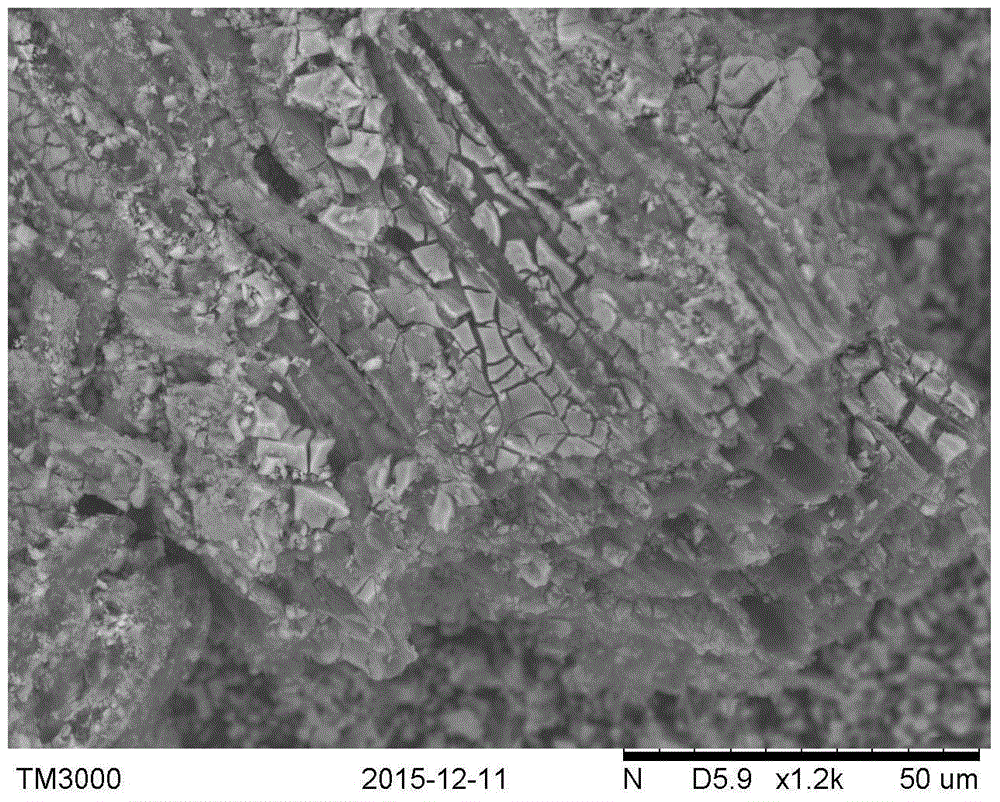TiO2-loaded biochar composite material and preparation method and application thereof
A technology of composite materials and biochar, applied in chemical instruments and methods, water pollutants, chemical/physical processes, etc., to achieve the effects of short production cycle, reduced preparation cost and time, and high product recovery rate
- Summary
- Abstract
- Description
- Claims
- Application Information
AI Technical Summary
Problems solved by technology
Method used
Image
Examples
Embodiment 1
[0027] A kind of biochar loaded TiO of the present invention 2 For the preparation of composite materials, the biochar raw material is selected from ramie stalks with leaves and skins removed, and the specific preparation method is as follows:
[0028] Wash the ramie stalks with the leaves and skins removed with deionized water, then dry them at 80°C for 24 hours, crush the dried ramie stalks, and pass through a 2mm sieve to obtain ramie stalk powder; add 10mL tetra-n-butyl titanate Slowly added to 15ml of absolute ethanol, the mixture was stirred on a constant temperature magnetic stirrer at a speed of 200 rpm for 20min to form a yellow clear solution; 2g of biomass powder was added and stirred for 30min to obtain a suspension A; 5ml of glacial acetic acid and 5 mL of deionized water was mixed with 5 mL of absolute ethanol, and the mixture was stirred on a constant temperature magnetic stirrer at a speed of 200 rpm for 10 minutes to obtain solution B. Add solution B dropwise...
Embodiment 2
[0031] Biochar loaded TiO of the present invention 2 The composite material is used to treat saffron red T in wastewater, comprising the following steps:
[0032] Get 50mL of saffron red T solution whose initial concentration is 100~500mg / L, add the biochar-loaded TiO prepared in Example 1 2 Composite materials, the amount of the adsorbent is 0.1g, and the photocatalytic reaction is carried out in a constant temperature incubator at 27°C. After 2 hours, the photocatalyst is separated from the waste water by centrifugation, and the untreated waste water in the waste water is measured at 530nm by a spectrophotometer. Degrade the content of saffron red T, the calculated degradation results are shown in table 1:
[0033] Table 1: Degradation data of photocatalyst under different initial concentrations of saffron T
[0034]
[0035] As can be seen from Table 1, the catalyst agent has a degradation capacity of 23.3 mg / g under the condition of 50 mg / L at the initial concentratio...
Embodiment 3
[0037]Biochar loaded TiO of the present invention 2 The composite material is used to treat saffron red T in wastewater, comprising the following steps:
[0038] Get 50mL initial concentration and be the saffron red T solution of 500mg / L, add the biochar loaded TiO that embodiment 1 makes 2 Composite materials, the amount of the catalyst is 0.05g, 0.1g, 0.15g, and the photocatalytic reaction is carried out in a constant temperature incubator at 27°C. After 2 hours, the photocatalyst is separated from the wastewater by centrifugation, and the photocatalyst is separated at 530nm by a spectrophotometer. Determination of the content of the undegraded saffron red T in the waste water, the calculated degradation results are shown in table 2:
[0039] Table 2: Degradation data of saffron red T under different catalyst amounts
[0040] Catalyst dosage (g) 0.05 0.1 0.15 Degradation amount (mg / g) 165.7 228.8 160.9
[0041] It can be seen from Table 2 that the...
PUM
| Property | Measurement | Unit |
|---|---|---|
| Adsorption capacity | aaaaa | aaaaa |
| Adsorption capacity | aaaaa | aaaaa |
Abstract
Description
Claims
Application Information
 Login to View More
Login to View More - R&D
- Intellectual Property
- Life Sciences
- Materials
- Tech Scout
- Unparalleled Data Quality
- Higher Quality Content
- 60% Fewer Hallucinations
Browse by: Latest US Patents, China's latest patents, Technical Efficacy Thesaurus, Application Domain, Technology Topic, Popular Technical Reports.
© 2025 PatSnap. All rights reserved.Legal|Privacy policy|Modern Slavery Act Transparency Statement|Sitemap|About US| Contact US: help@patsnap.com



